Many savory polenta bowls can feel heavy or overly rich, but this creamy Parmesan polenta with peas and poached eggs finds the perfect balance.
It’s smooth, buttery, and deeply satisfying without being fussy.
The combination of silky cornmeal, tender green peas, and perfectly poached eggs creates a cozy, restaurant-style meal that’s surprisingly simple to make at home.
The Beauty of a Simple Polenta Bowl
Polenta, made from ground cornmeal, has long been a staple in Italian kitchens. It’s versatile, affordable, and adaptable to both humble and refined dishes.
When cooked slowly and finished with a touch of butter and grated cheese, it transforms into a luxuriously creamy base that rivals mashed potatoes in comfort but with far less effort.
This version pairs Parmesan polenta with sweet peas and softly poached eggs, creating layers of texture and flavor. Each bite brings together savory richness from the cheese, the gentle sweetness of peas, and the lush creaminess of the egg yolk.
Why You’ll Love This Dish
This dish strikes the perfect middle ground between comfort and elegance. It feels like a brunch favorite yet works equally well for a quick weeknight dinner.
It’s versatile enough to customize — change the herbs, add roasted vegetables, or drizzle with infused olive oil. The core ingredients remain approachable, while the end result feels indulgent.
For anyone who appreciates easy yet elevated meals, this polenta bowl offers all the satisfaction of comfort food with the finesse of something special.
Choosing the Right Polenta
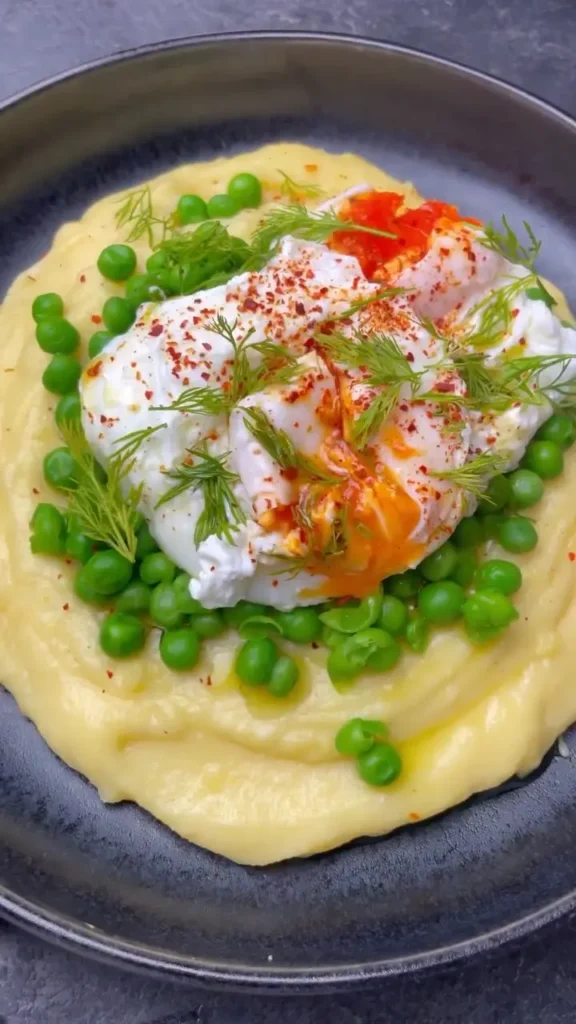
The foundation of this dish is polenta, and choosing the right type makes a noticeable difference. Coarse-ground or traditional polenta delivers a more rustic, hearty texture, while instant polenta cooks faster and still produces a creamy finish when handled correctly.
If you have extra time, slow-cooking the polenta over gentle heat allows the grains to bloom fully, creating a creamier result. For quick meals, instant or quick-cooking polenta is perfectly fine — just be sure to whisk continuously to prevent lumps.
Building Flavor: Butter and Parmesan
What makes this version stand out is its cheesy, buttery depth. Butter adds richness and a velvety texture, while Parmesan brings nutty, salty complexity that complements the mild sweetness of cornmeal.
For a slightly sharper or deeper flavor, you can experiment with aged Parmesan or even a touch of Romano cheese. If you prefer a lighter version, substitute part of the butter with olive oil while keeping enough fat to preserve that silky texture.
The Role of Peas
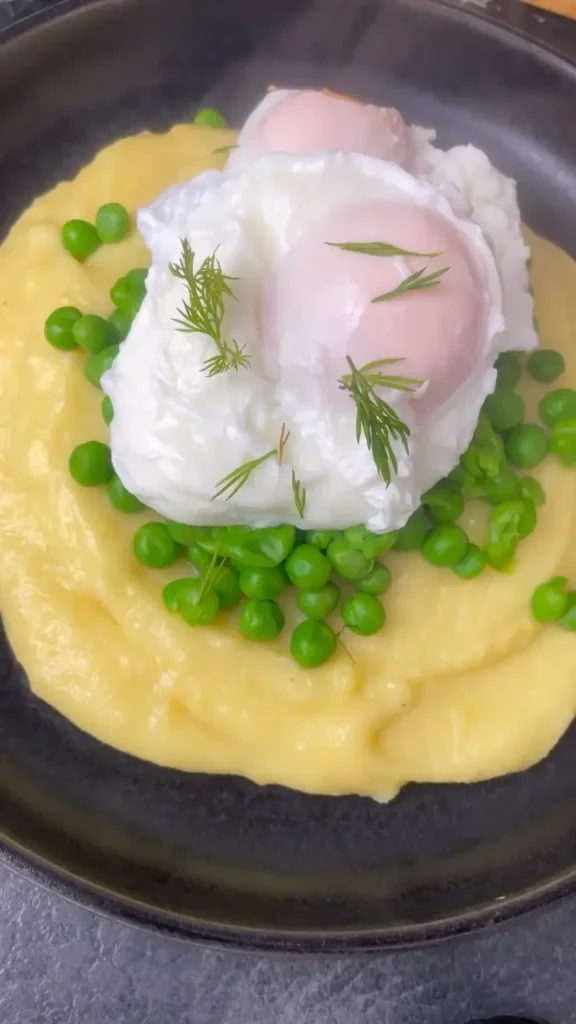
Peas might seem like a humble addition, but they provide brightness and color that perfectly offsets the richness of the polenta. Their natural sweetness balances the savory elements, while their texture adds a pleasant pop.
Fresh or frozen peas both work beautifully here. If using frozen peas, there’s no need to thaw them in advance — just drop them into boiling water for two minutes until tender and vibrant. You can also sauté them lightly in butter for a slightly deeper flavor.
Adding herbs such as mint, dill, or parsley enhances the freshness, giving each spoonful a hint of garden flavor.
Perfectly Poached Eggs
Poaching eggs can seem intimidating, but with the right technique, it’s straightforward and rewarding. The key is using fresh eggs and maintaining water that’s just below a simmer.
Crack each egg into a small bowl before gently sliding it into the water. Cook for about four minutes for set whites and a luxuriously runny yolk. If you prefer firmer yolks, let them cook for another minute.
When ready, lift each egg with a slotted spoon and place it gently on the polenta. As you cut into the egg, the golden yolk flows into the creamy cornmeal — the defining moment that makes this dish so comforting.
Balancing Texture and Presentation
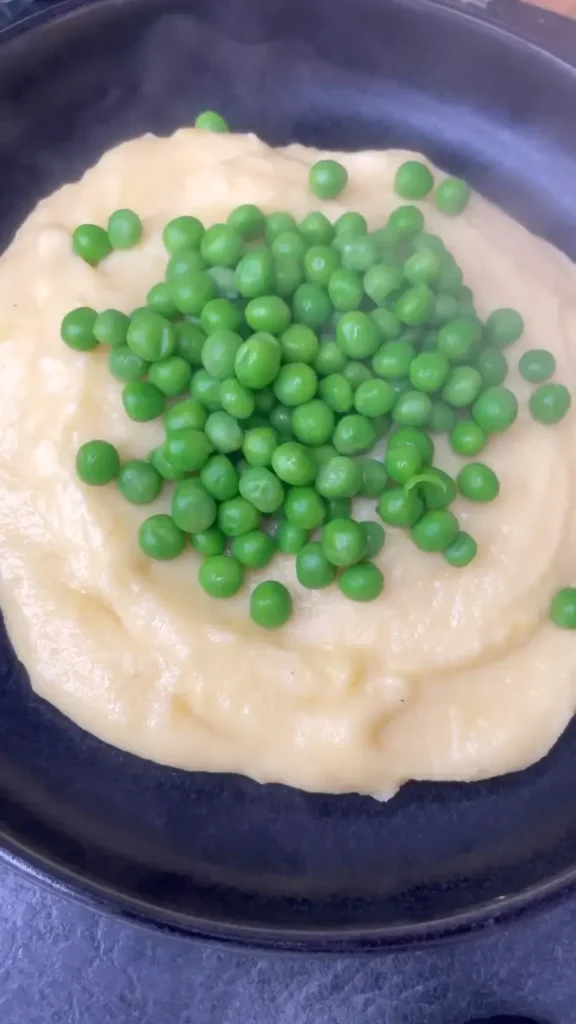
Visual appeal matters, even in a simple home-cooked meal. The soft yellow polenta, bright green peas, and white poached eggs create a color contrast that’s both inviting and elegant.
To finish, drizzle lightly with olive oil and sprinkle with chili flakes or cracked black pepper. The mild heat enhances the flavor without overpowering it.
A scattering of fresh herbs provides both aroma and a finishing touch that ties everything together. Dill offers a grassy sharpness, mint a cooling sweetness, and parsley a clean, classic note.
Variations to Try
This recipe serves as a flexible base you can adapt to your taste or pantry. You can turn it into a vegetarian main course or expand it with more protein and vegetables.
Add sautéed mushrooms for an earthy layer, or top with roasted tomatoes for a burst of acidity. For more crunch, sprinkle toasted nuts or seeds on top.
If you enjoy grain-based comfort dishes, you might also appreciate the creamy mushroom pasta for similar flavors in a different format.
For a lighter yet equally comforting option, try zucchini carrot fritters served with a dollop of yogurt sauce — both dishes highlight the joy of simple ingredients prepared thoughtfully.
The Step-by-Step Cooking Flow
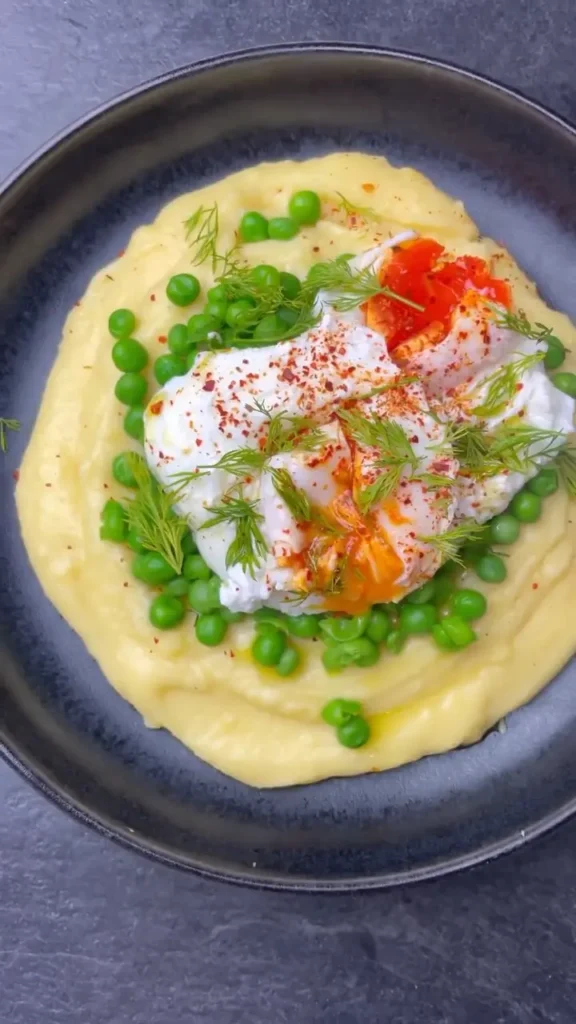
Start by bringing water to a boil in a saucepan. Slowly pour in your polenta while whisking constantly to prevent lumps. This part is key — gradual mixing ensures a smooth texture.
After about five minutes, the polenta will thicken. Stir in butter and grated Parmesan, then continue to cook gently for another few minutes until it reaches a creamy, velvety consistency.
While the polenta finishes cooking, bring two additional pans of water to a boil — one for the peas, one for the eggs.
Cook the peas for two minutes, just until bright and tender. Poach the eggs in the other pan for around four minutes, ensuring the whites are firm but the yolks remain soft.
When everything is ready, spoon the polenta into a shallow bowl. Top with peas, add the poached eggs, and finish with herbs, chili flakes, and a drizzle of olive oil.
Tips for the Best Results
Keep the whisk moving during the first few minutes of cooking polenta to avoid clumps. If it thickens too much, loosen it with a splash of hot water or milk.
Use finely grated Parmesan so it melts evenly into the mixture, avoiding grainy pockets.
If you’re cooking for a group, prepare the polenta first and keep it warm over very low heat, stirring occasionally. Poach the eggs just before serving so they’re fresh and glossy.
A drizzle of quality extra-virgin olive oil just before serving enhances the flavor and helps tie the elements together.
Storing and Reheating
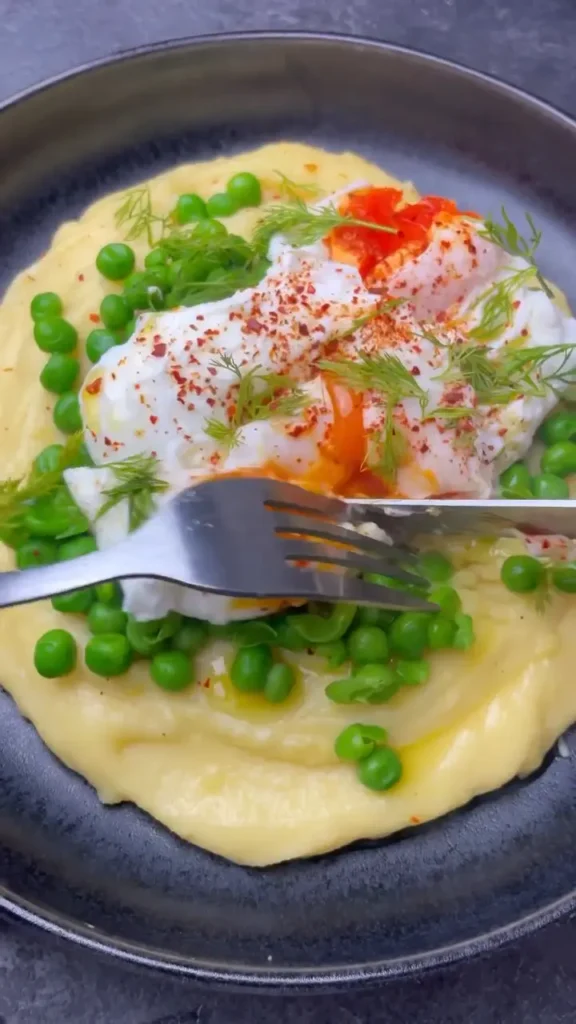
Leftover polenta firms up as it cools, but it’s easy to revive. Add a splash of water or milk and reheat gently on the stovetop, stirring until creamy again.
You can also repurpose cooled polenta by cutting it into squares and pan-frying until crisp — a delicious twist for another meal.
Cooked peas and eggs are best enjoyed fresh, but if you’re storing leftovers, keep the components separate and reassemble just before serving.
Pairing Ideas
This dish stands beautifully on its own, but you can also treat it as part of a larger meal. Serve alongside roasted vegetables or a fresh salad with citrus dressing to add brightness.
For a heartier dinner, pair it with something like herb-roasted whole chicken with cinnamon vanilla sweet potatoes. The creamy texture of the polenta complements the crispness of the roast perfectly.
If you prefer a plant-based pairing, grilled asparagus or marinated artichokes offer a wonderful contrast in flavor and texture.
Making It Your Own
The beauty of this recipe lies in its adaptability. Once you master the base, you can adjust the elements to fit any season or occasion.
Swap peas for sautéed spinach in winter, or fresh corn kernels in late summer. Replace Parmesan with a milder or more robust cheese depending on your taste.
For a brunch twist, add smoked salmon or roasted cherry tomatoes. For dinner, finish with a sprinkle of toasted breadcrumbs or crushed nuts for texture.
Small changes can refresh the entire experience while keeping the dish grounded in its comforting simplicity.
Frequently Asked Questions
Can I make this polenta bowl ahead of time?
Yes. You can cook the polenta in advance and store it in the refrigerator for up to two days. When reheating, add a bit of warm water or milk to restore creaminess. The eggs should always be poached fresh before serving.
What can I use instead of Parmesan?
Aged Pecorino or any hard, salty cheese with nutty notes works well. Just adjust the salt level accordingly, as some cheeses are more intense than others.
Can I add other vegetables?
Absolutely. Spinach, roasted bell peppers, mushrooms, or even wilted kale blend beautifully into the dish. The key is maintaining balance so the polenta remains the star.
How do I keep poached eggs from spreading in the water?
Use the freshest eggs you can find, and create a gentle whirlpool in the water before adding the egg. The swirling motion helps the whites wrap neatly around the yolk.
Is this recipe gluten-free?
Yes, polenta is naturally gluten-free, making it an excellent choice for those avoiding wheat-based grains. Just ensure your other ingredients are certified gluten-free if necessary.
What’s the best texture for serving polenta?
It depends on preference. For this dish, aim for soft, spoonable polenta that’s creamy but holds its shape slightly when plated. If it feels too thick, loosen it with a bit of hot liquid.
This creamy Parmesan polenta with peas and poached eggs is a celebration of simple ingredients made extraordinary through thoughtful preparation. It’s an easy, satisfying dish that fits breakfast, lunch, or dinner, offering comfort in every spoonful.

Creamy Parmesan Polenta with Peas and Poached Eggs
Ingredients
Method
- Bring 300ml of water to a boil in a saucepan.
- Slowly whisk in the polenta to avoid lumps.
- Cook gently for 5 minutes, stirring frequently.
- Add butter and grated Parmesan, mixing until smooth and creamy.
- Continue to cook gently for another 5 minutes until polenta reaches desired consistency.
- Bring two additional pans of water to a boil — one for the peas and one for the eggs.
- Cook the peas for 2 minutes until tender and bright green.
- Poach the eggs in the second pan for about 4 minutes for soft yolks.
- Spoon the polenta into a bowl.
- Top with cooked peas and poached eggs.
- Garnish with fresh herbs, a sprinkle of chilli flakes, and a drizzle of olive oil.
Notes
- Use fresh herbs like dill, parsley, or mint for added freshness.
- Polenta thickens as it cools; loosen with water or milk if needed when reheating.


Leave a Reply